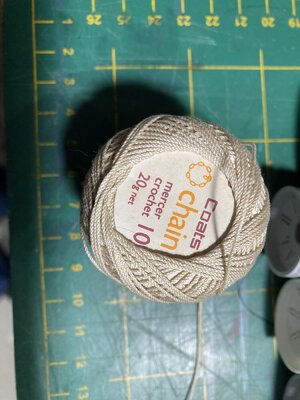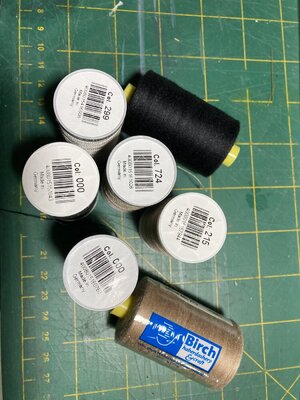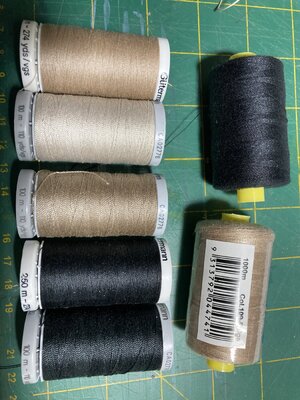Not sure if this is the correct forum to ask this but. In rope making, Gutermann colours 696 Mahogany and 722 beige feature prominently. What are the equivalent or closest colours in The Amann Serafil range? looking forward to your expert relies and thank you in anticipation. Cheers.
You are using an out of date browser. It may not display this or other websites correctly.
You should upgrade or use an alternative browser.
You should upgrade or use an alternative browser.
Its purely a personal choice. Just go with rope colours that you like. We use black or dark grey for the standing rigging, and whatever rendition of natural rope colour for the running rigging.
- Joined
- Apr 15, 2021
- Messages
- 212
- Points
- 213

I happen to have the color cards for both Gutermann and Aman Serafil. The closest to beige 722 is 861 for dark brown 696 it's 1003 or 1002 they are both similar. color 7769 is a good tan color also. Check out https://www.toko-kurzwaren.de/ they have the Serafil color cards and then you can choose for yourself. One thing to note is that Serafil is quite shiny. They have Gutermann E on that site, which is a fantastic thread to work with for rope making. It comes in 722 and 696 but I would also recommend the color 186 for tan rigging.
I hope that helps!
I hope that helps!
Thank you Bryian. Cheers.Its purely a personal choice. Just go with rope colours that you like. We use black or dark grey for the standing rigging, and whatever rendition of natural rope colour for the running rigging.
Hi BenD, I have checked out 'toko-kurzwaren.de' but it requires too much translating. Also postage from Europe to NZ requires a second mortgage same as from the States which is even worse price wise. I have a contact that is sending me the Serafil colour card which may or may not get here in time for my contact's order placement with Germany. (I think half the nation is home sick with Omicron or isolating so nothing moves fast) I'll use your suggested colours if the courier falls short.I happen to have the color cards for both Gutermann and Aman Serafil. The closest to beige 722 is 861 for dark brown 696 it's 1003 or 1002 they are both similar. color 7769 is a good tan color also. Check out https://www.toko-kurzwaren.de/ they have the Serafil color cards and then you can choose for yourself. One thing to note is that Serafil is quite shiny. They have Gutermann E on that site, which is a fantastic thread to work with for rope making. It comes in 722 and 696 but I would also recommend the color 186 for tan rigging.
I hope that helps!
Gutermann series is very limited here in NZ and sewing outlets have no idea about Mara, Serafil etc - Once again many thanks to you.
- Joined
- Apr 15, 2021
- Messages
- 212
- Points
- 213

If you have Chrome as a browser it can automatically translate pages. Auto translate is also helpful on this website since there are plenty of people using other languages.Hi BenD, I have checked out 'toko-kurzwaren.de' but it requires too much translating. Also postage from Europe to NZ requires a second mortgage same as from the States which is even worse price wise. I have a contact that is sending me the Serafil colour card which may or may not get here in time for my contact's order placement with Germany. (I think half the nation is home sick with Omicron or isolating so nothing moves fast) I'll use your suggested colours if the courier falls short.
Gutermann series is very limited here in NZ and sewing outlets have no idea about Mara, Serafil etc - Once again many thanks to you.
https://www.toko-kurzwaren.de/ has a flat rate for shipping to NZ of 30 euros. It's quite expensive so yeah if you can get your contact to help, do that.
Done that, can now read German LOL. Hey thank you for the info and help.If you have Chrome as a browser it can automatically translate pages. Auto translate is also helpful on this website since there are plenty of people using other languages.
https://www.toko-kurzwaren.de/ has a flat rate for shipping to NZ of 30 euros. It's quite expensive so yeah if you can get your contact to help, do that.
Hi again Bryian, I was never aware that Black/dark Grey could be used for standing rigging. Being extremely new to ship modelling I've relied heavily on what the You tubers and various sites state as colour to be used. I'm finding members like you and SOS to be an affable and information sharing site. Cheers Bryian.Its purely a personal choice. Just go with rope colours that you like. We use black or dark grey for the standing rigging, and whatever rendition of natural rope colour for the running rigging.
Standing rigging was tarred, so a rendition of black/ charcoal or very dark grey would be suitable.
This is my collection of Gutermann threads
Е121 - for making ropes
Tera 180 - for seizings
Skala 36 - for painting in any colour with bitumen varnish
Е121 - for making ropes
Tera 180 - for seizings
Skala 36 - for painting in any colour with bitumen varnish
1. If you go to a ship chandler that has some vegetable fiber rope (preferably hemp rope) you will see that the color of real rope (yellowish/orangeish) is a combination of approximately 15% raw umber and 85% yellow ochre. These colors are available in tubes at any art supply store in water, alkyd and oil bases. The water base works best. Variations in the rope colors can be achieved by putting in very minute amounts of warm colors (red, orange, tan, gray, white. etc). No greens or blues. There were no green or blue ropes in 1750. Ropes were never black or white (contemporary models usually have dirty brown colored rigging, but what do you expect after 300 years?). This black/white myth has been propagated for quite awhile, but it is totally wrong. Processed tree sap (heating the tree sap produced tar) was used as a preservative. Stockholm tar was the highest grade tar made then (and probably today). The best grades of tar had a light tan color. The bottom grade of tar had a dark brown color. You can buy wood sap tar over the internet today (amazon.com). It costs about 20 bucks per quart. I wouldn't waste money on a lot of high priced fake colors. Go to an art store and get the real thing. Almost every rope on a ship would have had a different color; origin of the rope fibers, aging, sunshine, salt, cooking waste (slush), etc would all have contributed to a rainbow of subtle colors.
Thank you very much for your input. This defines the Gutermann range I need to pursue. I have identified a couple of British & European outlets that hold stock. I will purchase later in the year subject to postal costs. I've watched your Rope making videos frame by frame. Hopefully one day I'll manage consistency. Again, thank you.This is my collection of Gutermann threads
Е121 - for making ropes
Tera 180 - for seizings
Skala 36 - for painting in any colour with bitumen varnish
Great explanation(s) Thank you. I'm pleased to find someone else that understands colour and the inconsistency of colours as effected by outside elements, light, age, manufacturing processes, application and usage. Very valuable information you have given especially the use of artist acrylics. On the subject of 'Black' there are many variations of black including red or brown blacks. Perhaps this is what is referenced by some modellers. Being 100% novice at wooden ship modelling the best bet for me would be to stay with dark brown threads and dirty off white colours for my enjoyable rope making attempts and disasters...... Cheers.1. If you go to a ship chandler that has some vegetable fiber rope (preferably hemp rope) you will see that the color of real rope (yellowish/orangeish) is a combination of approximately 15% raw umber and 85% yellow ochre. These colors are available in tubes at any art supply store in water, alkyd and oil bases. The water base works best. Variations in the rope colors can be achieved by putting in very minute amounts of warm colors (red, orange, tan, gray, white. etc). No greens or blues. There were no green or blue ropes in 1750. Ropes were never black or white (contemporary models usually have dirty brown colored rigging, but what do you expect after 300 years?). This black/white myth has been propagated for quite awhile, but it is totally wrong. Processed tree sap (heating the tree sap produced tar) was used as a preservative. Stockholm tar was the highest grade tar made then (and probably today). The best grades of tar had a light tan color. The bottom grade of tar had a dark brown color. You can buy wood sap tar over the internet today (amazon.com). It costs about 20 bucks per quart. I wouldn't waste money on a lot of high priced fake colors. Go to an art store and get the real thing. Almost every rope on a ship would have had a different color; origin of the rope fibers, aging, sunshine, salt, cooking waste (slush), etc would all have contributed to a rainbow of subtle colors.
Hi ConsNZ,
I just did a search and there is a store in Auckland, NZ that seem to have a good range of Gutermann threads in stock.
https://www.ribbonrose.co.nz/products/category/65/395/gutermann/sewing-threads
Otherwise over the ditch in AU, Spotlight have a good range of Gutermann thread.
I would recommend buying some cheep thread to get the hang of making your own as you will probably go through a bit, Gutermann thread is fairly expensive in comparison to low cost stuff.
Cheers,
Stephen.
I just did a search and there is a store in Auckland, NZ that seem to have a good range of Gutermann threads in stock.
https://www.ribbonrose.co.nz/products/category/65/395/gutermann/sewing-threads
Otherwise over the ditch in AU, Spotlight have a good range of Gutermann thread.
I would recommend buying some cheep thread to get the hang of making your own as you will probably go through a bit, Gutermann thread is fairly expensive in comparison to low cost stuff.
Cheers,
Stephen.
Hi Steve, I buy from Ribbon Rose, Gutermann Polyester thread 1,000metre spools (NZD8.70 x spool. AUD7.94 x spool) which is available in one size only, 80 Tex I'm told. Other thicknesses are available but they appear too heavy for my La Pinta. Spotlight is a short bike ride from here but sadly they deal only in a limited Gutermann range. Young shop staff are lovely and try very hard to find answers for me. One even said I make the dept learn lots of different thread stuff. I'll check out Spotlight Aust later today. Thank you very much for looking and referring back to me...CheersHi ConsNZ,
I just did a search and there is a store in Auckland, NZ that seem to have a good range of Gutermann threads in stock.
https://www.ribbonrose.co.nz/products/category/65/395/gutermann/sewing-threads
Otherwise over the ditch in AU, Spotlight have a good range of Gutermann thread.
I would recommend buying some cheep thread to get the hang of making your own as you will probably go through a bit, Gutermann thread is fairly expensive in comparison to low cost stuff.
Cheers,
Stephen.
No sweat ConsNZ,Hi Steve, I buy from Ribbon Rose, Gutermann Polyester thread 1,000metre spools (NZD8.70 x spool. AUD7.94 x spool) which is available in one size only, 80 Tex I'm told. Other thicknesses are available but they appear too heavy for my La Pinta. Spotlight is a short bike ride from here but sadly they deal only in a limited Gutermann range. Young shop staff are lovely and try very hard to find answers for me. One even said I make the dept learn lots of different thread stuff. I'll check out Spotlight Aust later today. Thank you very much for looking and referring back to me...Cheers
I have bought thread from Spotlight locally in 2 different diameters although I think they were shorter that 1000 meters.
Cheers,
Stephen.
1. Buying pre-colored commercial thread (think Gutterman and others) is a very expensive way to go. The European builders (especially the French) use DMC cotton crochet thread for their raw rigging material; DMC is a French company. You can buy DMC in the US from knitting-warehouse.com. You can buy sizes 3 (diam is about 0.03") through 100 (diam is approx 0.008" (you can also get size 120 in Europe, size about size 0.005: diam); commercial thread on a spool is almost always size 50 (0.01" diam). You can use both 3SRH and 2SLH. ES for running rig and 2S for use on a rope-walk (mainly for LH anchor cables, stays and shrouds).Thank you very much for your input. This defines the Gutermann range I need to pursue. I have identified a couple of British & European outlets that hold stock. I will purchase later in the year subject to postal costs. I've watched your Rope making videos frame by frame. Hopefully one day I'll manage consistency. Again, thank you.
2. You can buy a lifetimes worth of DMC for 20 bucks (mainly size 50 to 100) and you do not have to concern yourself with all the dye lot and "model" numbers. By now (after 20 years) I have a bankers box worth (really a century's worth) of the white "raw" threads (plus a lot of specialty quilting threads down to size 120- a book in itself) and a hundred (or more) spools (spools are the cardboard inserts from toilet paper rolls) of colored and "rope-walked" ropes" ready to go; you can color, rope-walk and accumulate "ropes" very quickly in every imaginable color, twist and size.
3. A book's worth of info in 2 paragraphs!
All of these great ideas! I really need a rope walk.
Lots of info and pointers. Again thank you for the useful information. Super competitive prices in the US are normally killed off by US Postage/Shipping etc ----- unfortunately.1. Buying pre-colored commercial thread (think Gutterman and others) is a very expensive way to go. The European builders (especially the French) use DMC cotton crochet thread for their raw rigging material; DMC is a French company. You can buy DMC in the US from knitting-warehouse.com. You can buy sizes 3 (diam is about 0.03") through 100 (diam is approx 0.008" (you can also get size 120 in Europe, size about size 0.005: diam); commercial thread on a spool is almost always size 50 (0.01" diam). You can use both 3SRH and 2SLH. ES for running rig and 2S for use on a rope-walk (mainly for LH anchor cables, stays and shrouds).
2. You can buy a lifetimes worth of DMC for 20 bucks (mainly size 50 to 100) and you do not have to concern yourself with all the dye lot and "model" numbers. By now (after 20 years) I have a bankers box worth (really a century's worth) of the white "raw" threads (plus a lot of specialty quilting threads down to size 120- a book in itself) and a hundred (or more) spools (spools are the cardboard inserts from toilet paper rolls) of colored and "rope-walked" ropes" ready to go; you can color, rope-walk and accumulate "ropes" very quickly in every imaginable color, twist and size.
3. A book's worth of info in 2 paragraphs!
Hi ConsNZ,
Way back when I have used crochet thread, to me it looked alright and came in a range of diameter's see photo of one of them.

Buying Gutterman is not cheap. The photo shows what I bought from Spotlight and set me back around AU $60, there are 2 different diameters.
The Birch stuff was comparatively cheap but a bit "furry", I thought it would be good to use to learn how to make rope with.


Cheers,
Stephen.
Way back when I have used crochet thread, to me it looked alright and came in a range of diameter's see photo of one of them.

Buying Gutterman is not cheap. The photo shows what I bought from Spotlight and set me back around AU $60, there are 2 different diameters.
The Birch stuff was comparatively cheap but a bit "furry", I thought it would be good to use to learn how to make rope with.


Cheers,
Stephen.




